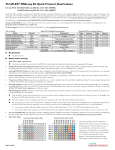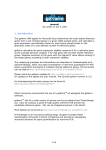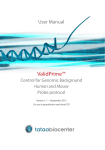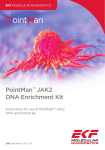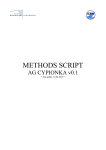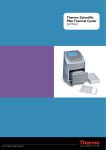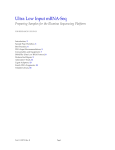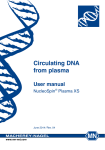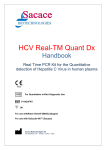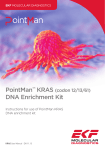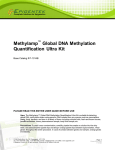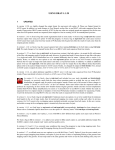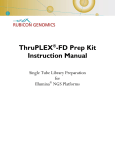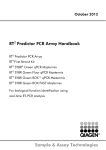Download Chromofy user manual - Gene
Transcript
User Manual Chromofy™ dsDNA binding dye Version 1.0 — April 2009 For use in quantitative real-time PCR Chromofy™ dsDNA binding dye Table of contents Background 4 Contents 4 Storage 4 Fluorescence data 4 Additionally required materials and devices 5 Typical results using Chromofy™ 6 Instructions for use 7 Safety 7 Troubleshooting 8 Contact 9 License information 9 Other products from Tataa 10 3 Background Chromofy is a monomeric cyanine dye developed by TATAA Biocenter for use in real-time PCR applications. The dye has absorbance and emission wavelengths suitable for the FAM/SYBR channel on most common real-time PCR instrumentation and shows a very strong fluorescence increase when bound to dsDNA. Chromofy can be used as an unspecific DNA binding dye for real-time PCR applications or other applications where staining of dsDNA is wanted. Contents • 25 µl 5000x stock solution of Chromofy in DMSO. Sufficient for approximately 5000 25 µl qPCR reactions. Fluorescence data Maximum absorbance has been determinde to 482 nm and maximum emission at 507 nm, when bound to dsDNA. The fluorescence increases approximately 450 times when the dye binds to dsDNA. Normalized Absorbance/Fluorescence 14000 12000 RFU 10000 8000 6000 4000 2000 1 0,8 0,6 0,4 0,2 0 0 490 530 570 610 650 690 730 Wave length (nm) Figure 1: Fluorescence intensity of free Chromofy (red) and in presence of dsDNA (blue). 250 310 370 430 490 550 610 670 733 Wave length (nm) Figure 2: Absorption and emission spectra of Chromofy Storage The stock solution can be stored at +4oC for up to 12 months. Once diluted in buffer the dye can be stored at +4oC for at least 1 month. Repeated freeze-thaw cycles are not recommended. 4 Chromofy™ dsDNA binding dye Additionally required materials and devices • Real-time PCR instrumentation The product has been validated on several different instrument platforms. Note: Using Chromofy on certain instruments may need calibration. Most instruments can directly use the FAM/SYBR-channel to monitor the Chromofy signal. • Mastermix or mastermix components The dye has been tested using many commercially available mastermixes, including Quantace Sensimix, Roche LightCycler480 probe mix, Fermentas Maxima probe, Finnzymes Dynamo Flash probe mix, Quantace HRM mix and PrimerDesign Precision HRM mix. Note: The use of Chromofy in certain mastermixes results in a lower and noisier amplification and dissociation curve signal. This has been noticed for example with Applied Biosystems TaqMan Universal Mastermix. • Pipettes and tips • Vortex and centrifuge • Sample cDNA Optimal results in qPCR require high quality DNA samples. Quality of RNA can be tested prior to cDNA synthesis using Agilent 2100 Bioanalyzer or BioRad Experion. 5 Typical results using Chromofy™ Chromofy can be used as a non-specific reporter of dsDNA products and in High-Resolution Melt (HRM) applications. The end fluorescence level of Chromofy is slightly lower than SYBRgreen I and similar to Evagreen. It is recommended to use a high gain setting, if the instrument supports this. Also, the resulting Ct-values may be shifted to lower or higher values depending on the mastermix used. The melting temperature of the PCR product is similar or lower than when using SYBR green I. 35 Ct (dR) 30 25 20 15 10 1 2 3 4 5 6 7 Initial Quantity (log copy number) Figure 3: Standard curve using Chromofy and Roche LightCycler 480 probe mix. Efficiency 100 %. Chromofy can also be used for HRM , which is a post PCR analysis where the melting temperature is used to analyze different sample characteristics. HRM is commonly used for genotyping with or without unlabelled probes, and for methylation analysis. Prior to the methylation analysis the DNA is always treated with bisulfite, which converts unmethylated cytosines to uracil that during the PCR will be substituted for thymines. This will result in a methylated sample having higher melting temperature than an unmethylated sample due to higher GC content. 6 Chromofy™ dsDNA binding dye Figure 4: Chromofy can easily distinguish between the wild type (G) and mutant (A) genotypes of the Factor V Leiden SNP (Rotorgene6000). Figure 5: HRM methylation analysis using Chromofy and Rotorgene 6000. The assay is sensitive down to 1% methylated DNA in unmethylated background, each control in tetraplicates. Instructions for use 25 µl of stock solution is supplied at 5000x in DMSO and is stable for up to 12 o months at 4 C. Before use dilute the stock 1:100 to a working solution of 50x in TE buffer pH 8 (e.g. Tris EDTA 100x buffer concentrate T-9285 from SIgma) by adding 2 µl of the stock solution to 198 µl buffer. This can be scaled up for larger volumes. A solution of 50 x is stable for more than 1 month at 4oC. Typical concentration in real-time PCR reactions is 1-2 x, optimal concentration may vary depending on the mastermix. Detection should be done on the FAM/SYBR channel. The dye can be used with most commercially available real-time PCR reagents. The quality of signal may depend on the chemistry used and on the filter settings on the real-time PCR platform. If the instrument used has variable gain settings, Chromofy should generally be used at a high gain setting. Safety As Chromofy binds to DNA it is a potential mutagen and should be treated as such. 7 Troubleshooting • I do not get any amplification/signal? The instrument may not have been programmed correctly. You can evaluate if the problem is in the detection or the amplificiation by running the samples on gel. Make sure the Chromofy dye is monitored in the appropriate channel and that the instrument is calibrated if necessary. •I get a very noisy amplification and dissociation curve The quality of signal may depend on the chemistry used and on the filter settings on the real-time PCR platform. If the instrument used has variable gain setting, try to increase the gain. Make sure also that if the instrument requires calibration that this is performed. Changing the mastermix can also improve the signal. •My negative controls give a positive amplification? Since Chromofy is a dsDNA binding dye it will also bind to non-specific products such as primer dimers. Amplification of non-specific products will lead to an amplification signal. The amplified product can be evaluated by doing dissociation curve analysis. •My samples have same/higher Ct-value than my negative controls? This indicates that you have added too little DNA. Add more DNA and try again. The DNA may be of low quality. Check the quality of the RNA before doing cDNA synthesis. •My replicates are not very tight? With good quality DNA and good pipetting technique, very high reproducibility is possible. Low amounts of DNA can lead to higher variation. Also, low quality DNA can lead to big differences between replicates. 8 Chromofy™ dsDNA binding dye Contact For more information about the product and other products available from TATAA Biocenter please contact us on [email protected] or visit our website www.tataa.com. License information The purchase of this product conveys to the buyer the non-transferable right to use the purchased amount of the product and components of the product in research conducted by the buyer (whether the buyer is an academic or for-profit entity). The buyer cannot sell or otherwise transfer (a) this product (b) its components or (c) materials made using this product or its components to a third party or otherwise use this product or its components or materials made using this product or its components for commercial purposes. For information on purchasing a license to this product for purposes other than research, contact TATAA Biocenter AB, Odinsgatan 28, S-41103 Göteborg, Sweden, Phone: +46 31 761 57 00, Fax: +46 31 152890, Email: [email protected] PCR is covered by several patents owned by Hoffman-La Roche Inc. and Hoffman-LaRoche, Ltd. Purchase of the product does not include or provide a license with respect to any PCR-related patent owned by Hoffman-La Roche or others. TATAA Biocenter does not encourage or support the unauthorised or unlicensed use of the PCR process. 9 Other products from Tataa Human Endogenous Control Gene Panel A panel containing primer sets for 12 commonly used human reference genes. A perfect product for finding the most optimal reference gene for your samples. GenEX Light software is also included in the kit. Mouse Endogenous Control Gene Panel A panel containing primer sets for 12 commonly used mouse reference genes. A perfect product for finding the most optimal reference gene for your samples. GenEX Light software is also included in the kit. BOXTO A new dye for qPCR BOXTO is a derivative of BEBO and can also be used as a unspecific dye for real-time PCR applications. The dye has absorbance and emission wavelengths that can be detected on the JOE channel, and shows a very strong fluorescence increase when bound to dsDNA. GenEx software A software for gene expression analysis. GenEx provides the appropriate tools to analyze real-time PCR gene expression data and to extract valuable information from the measurements. TrulyStem - for Human Embryonic Stem Cell Characterization For easy monitoring of the differentiation state of stem cells using real-time PCR. The kit contains primer sets for 13 well established stem cell differentiation markers and positive control cDNA from differentiated and non-differentiated stem cells. CelluLyser - for rapid and easy lysis and cDNA synthesis The CelluLyser Lysis and cDNA Synthesis Kit enables you to generate cDNA from small samples with minimal losses and hands-on time, allowing even a single cell to be analysed. A rapid and sensitive lysis is followed by reverse transcription without the need of purification. 10 Express your genius TATAA Biocenter, with offices in Gothenburg, San Franscisco, Prague and Munich, is the leading provider of real-time PCR services and the prime organizer of real-time PCR workshops globally. TATAA Biocenter conducts commissioned research and training within field of molecu- lar diagnostics and gene expression analysis, along with developing realtime PCR expression panels. TATAA Biocenter have great experience and expertise in high resolution gene expression profiling, pathogen detection, and small sample/single cell analysis. TATAA Biocenter AB Odinsgatan 28, 411 03 Göteborg Tel: +46 31 761 57 00, Fax: +46 31 15 28 90 E-mail: [email protected], Website: www.tataa.com













